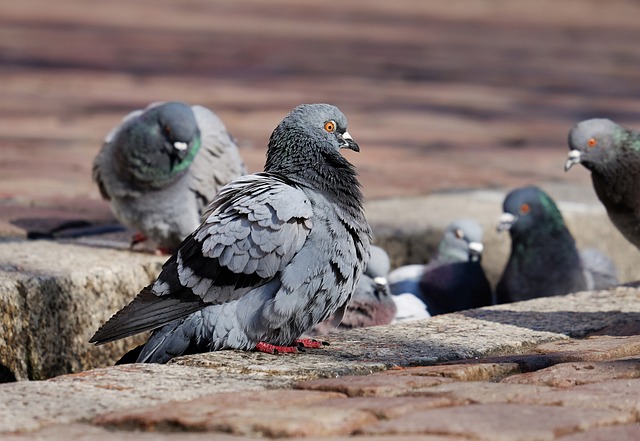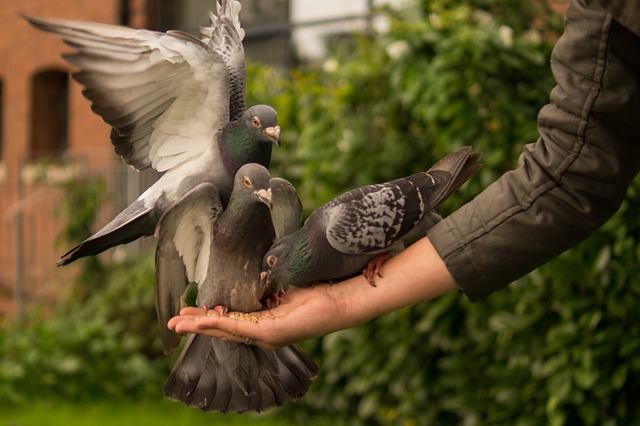In the world of pigeons, bowing is a fundamental behavior displayed by male birds during courtship. They mainly do this captivating display to attract suitable female mates and establish strong pair bonds.
Beyond courtship, pigeons engage in this behavior for various purposes, such as communication, social bonding, and thermoregulation. Understanding the intricacies of their courtship rituals sheds light on the fascinating dynamics of these remarkable birds.
However, by reading this article, you may satisfy your curiosity by asking, ‘Why do pigeons bow?’
6 habitual reasons why do pigeons bow?
Pigeons are renowned for their intriguing courtship rituals. They engage in a captivating behavior known as bowing. This display plays a vital role in attracting mates and establishing strong pair bonds. Let’s delve into the fascinating reasons behind this captivating behavior.
1. Competition for mates
During the mating season, male pigeons vie for the attention of a female. In this regard, bowing becomes a remarkable tactic to stand out.
Thus, the male showcases his physical prowess and courtship skills. They aim to outcompete rival suitors and capture the female’s interest.
2. Visual communication
Like many other birds, pigeons employ body language and postures as a form of communication. Bowing serves as a visual signal.
This sign conveys the male’s intentions and emotional state. It communicates his readiness to mate and his commitment to the courtship process.
3. Strengthening pair bonds
Bowing isn’t limited to courtship alone. Pigeons continue this behavior even after forming a pair bond. It reinforces the connection between the male and female. Thus they foster a strong and cohesive relationship throughout the breeding season and beyond.
4. Mutual evaluation
During courtship, both pigeons evaluate each other. The female assesses the male’s health, vigor, and genetic fitness through his bowing display. The male gauges the female’s receptiveness and condition based on her response to his courtship display.
5. Temperature regulation
Apart from courtship, bowing can serve other purposes. In warm weather, pigeons may bow as a means of thermoregulation. Thus, they try to expose lighter-colored feathers on their chests to dissipate excess body heat.
6. Reinforcing social bonds
Pigeons are social creatures, and bowing isn’t exclusive to courtship. Bonded pairs may engage in this behavior outside of the breeding season, reinforcing social bonds within the flock.

The act of bowing
Bowing is a fundamental behavior displayed by male pigeons during courtship. It is essential for attracting a suitable female partner and establishing a strong pair bond. However, let’s explore the steps involved in bowing.
1. Chest puffing
The male pigeon puffs out his chest, accentuating his physical health and strength. This behavior showcases his suitability as a potential mate.
2. Tail raising
The male raises his tail feathers, creating a visually striking posture that catches the female’s attention. This posturing is an important part of the courtship display.
3. Forward bowing
The male pigeon bows forward while maintaining the puffed chest and raised tail position. This action is a distinctive visual signal of his readiness to engage in courtship.
4. Cooing vocalization
During the bowing display, the male often produces soft and rhythmic cooing sounds. The cooing serves as a vocal accompaniment to the bowing and plays a vital role in courtship communication.
5. Female response
If the female pigeon is receptive to the male’s advances, she may respond by exhibiting submissive behaviors, indicating her interest in forming a pair bond.
6. Pair bonding
Successful courtship and mutual evaluation lead to the formation of a monogamous pair. The bonded pair collaborates in building a nest and raising their young together.
What Environmental Factors Influence the Frequency of Bowing by Pigeons?
The frequency of bowing behavior in pigeons is influenced by several environmental factors. They play a significant role in shaping their courtship rituals.
Even these factors can impact the frequency of bowing displays and the overall success of courtship. Let’s explore some of the key environmental factors.
- Temperature and Seasonal Changes: Breeding season and moderate temperatures trigger bowing.
- Daylight and Photoperiod: Changing daylight influences hormonal responses and courtship behaviors.
- Mate Availability: The presence and abundance of mates affect bowing frequency.
- Competition: High-population areas lead to more competitive courtship displays.
- Food Availability: Well-nourished pigeons display more energetic courtship behaviors.
- Predation Pressure: Pigeons adjust courtship based on perceived predation risk.
- Nesting Sites: Suitable and secure nesting locations impact bowing frequency.
- Human Interference: Urban settings can alter courtship behaviors around human activities.
- Social Structure: Dominance hierarchies and interactions with other pigeons influence bowing displays.

What other birds do bow like pigeons?
Several bird species display bowing or similar courtship behaviors as part of their mating rituals. Here are some examples of birds known for their courtship bowing.
| Bird Species | Courtship Bowing Behavior |
| Doves and Pigeons | Male pigeons bow forward to attract female mates. |
| Peafowls | Male peafowls (peacocks) bow and display their tail feathers during courtship. |
| Ruffed Grouse | Male ruffed grouse display a “drumming” behavior, bowing with raised feathers and making a drumming sound using their wings. |
| Red-capped Manakin | Male red-capped manakins perform a bowing dance to attract females, often involving acrobatic moves. |
| Sandhill Cranes | Sandhill cranes engage in elaborate dancing displays, including bowing and jumping. |
| Great Crested Grebes | These birds perform “weed dance,” involving bowing and presenting weed to potential mates. |
| Sage Grouse | Male sage grouse perform a “strutting” display that includes bowing and inflating air sacs on their chests. |
| Wilson’s Bird-of-Paradise | Male Wilson’s bird-of-paradise bows and performs intricate dances to attract females. |
| Gunnison Sage-Grouse | Male Gunnison sage-grouse perform courtship displays, including bowing and puffing their chests. |
FAQs
What are the signs of pigeons mating?
The signs of pigeons mating are:
- Mutual bowing displays
- Cooing and vocalizations
- Billing (touching beaks)
- The male pursuing the female with raised wings
- Nest-building together
- Increased affectionate behavior towards each other.
How do pigeons show aggression?
Pigeons show aggression through loud cooing, chasing, wing flapping, pecking, feather-ruffling, head bobbing, and physical blocking. These behaviors are part of their instinct to establish dominance, defend territory, and compete for resources or mates.
Do pigeons coo when happy?
Yes, pigeons coo as a form of vocalization that can indicate contentment, comfort, and a sense of security. While cooing is commonly associated with courtship and communication, pigeons may also coo when they are relaxed and content, expressing their well-being and positive emotional state.
Are pigeons loyal to their mate?
Yes, pigeons are known for their loyalty to their mates. Once a pair of pigeons form a bond, they typically stay monogamous throughout the breeding season and often even for life. They collaborate in nest-building, incubating eggs, and raising their young together, displaying a strong and lasting partnership.
Final Verdict
Bowing in pigeons showcases their innate courtship prowess and social dynamics. Mutual evaluation, visual communication, and vocal cooing help establish strong pair bonds.
Beyond courtship, it aids in temperature regulation and reinforces social bonds. Environmental factors influence the bowing frequency, providing insights into this captivating behavior’s evolutionary advantages.
Pigeons’ courtship rituals offer a mesmerizing glimpse into their avian world and the power of courtship displays.

